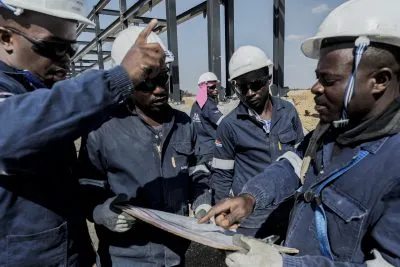‘We want to be a continental brand and we are aggressively investing in many African countries; to date we have a presence in 14. In some, we are building cement manufacturing plants, while in many other countries we are building import terminals and cement grinding plants’, Aliko Dangote
There is little doubt that rapid economic growth has triggered a construction boom. Housing projects, shopping malls and office blocks are springing up all over the country as developers seek to benefit from rising property prices. Plenty of mega projects and big deals have grabbed the headlines but any mention of construction in a report such as this automatically excludes the bulk of the sector. Most residential construction takes place one building or one block at a time and is carried out by small firms and so receives no coverage by the international media.
Yet there is one way to measure the health of an entire construction sector – through cement production.
New investment in cement plants means that Nigeria is likely to be transformed from being a cement importer into a net exporter. The government has considered introducing a ban on cement imports in the past but this may not be necessary following the development of modern large-scale production facilities within the country. Given that cement is a heavy commodity with relatively low value per tonne, it remains to be seen whether imports can compete with domestic production.
Dangote Cement opened its third plant in Ibese in Ogun State last year giving the company total production capacity of 20.25m tonnes a year. Just two months earlier, Lafarge WAPCO completed its 2.5m tonnes a year Ewekoro II plant, also in Ogun State, taking its capacity up to 8m tonnes a year. Dangote in particular plans further expansion, both in other African markets and in Nigeria itself. Given that the entire country had production capacity of just 1.9m tonnes a year in 2002, this is a remarkable success story.
Record output of cement
Aliko Dangote says: “We want to be a continental brand and we are aggressively investing in many African countries; to date we have a presence in 14. In some, we are building cement manufacturing plants, while in many other 40 African countries we are building import terminals and cement grinding plants. We will continue to expand our presence in Africa in order to consolidate our position as a leading African producer of cement.”
He continues: “Our view on the cement market is that housing construction absorbs the bulk of cement, but we are trying to encourage greater consumption in other areas, such as in concrete road construction. In our country, consumption per capita is about 125 kg per person. For a country with our level of development, it should be twice that. The way to increase our per capita consumption is to begin to create large concrete projects while continuing to increase the housing supply.” The government also has a policy of supporting smaller projects. A private pan-African housing institution, Shelter Afrique, has reached an agreement with Abuja to provide housing finance and advice to both lenders and borrowers. President Goodluck Jonathan said: “The federal government is looking at some other angles pertaining to the funding of housing. When we think about new towns we must work with key industrialists. If you construct new towns without jobs then there would be problems.”
A report by the National Economic Management team promoted the construction sector as a means of job creation. It stated:
“Our vision 20:2020 and financial system strategy 2020 have assigned special roles to the housing sector, expecting it to drive the financial system and contribute not less than 20% of GDP by the year 2020.”
The report added: “The construction of a medium-sized bungalow is capable of directly creating employment for an average of 76 workers. The number goes up significantly when the forward and backward linkages are factored into the process. Therefore for a 100 housing units scheme of twobedroom bungalows, up to 7,600 workers will be engaged for a period of between 12-18 months.”
Such figures seem unlikely but there is no doubt that the sector can create a great deal of employment through the use of bricklayers, electricians, plumbers, gardeners and others. The government can help by supporting vocational training in the required professions. Speaking at the Lagos International Trade Fair last year, the managing director of Lafarge WAPCO, Joe Hudson, said: “The construction sector is growing and the onus is on the professionals in the industry to keep up with the growth.”
Want to continue reading? Subscribe today.
You've read all your free articles for this month! Subscribe now to enjoy full access to our content.
Digital Monthly
£8.00 / month
Receive full unlimited access to our articles, opinions, podcasts and more.
Digital Yearly
£70.00 / year
Our best value offer - save £26 and gain access to all of our digital content for an entire year!
 Sign in with Google
Sign in with Google 


